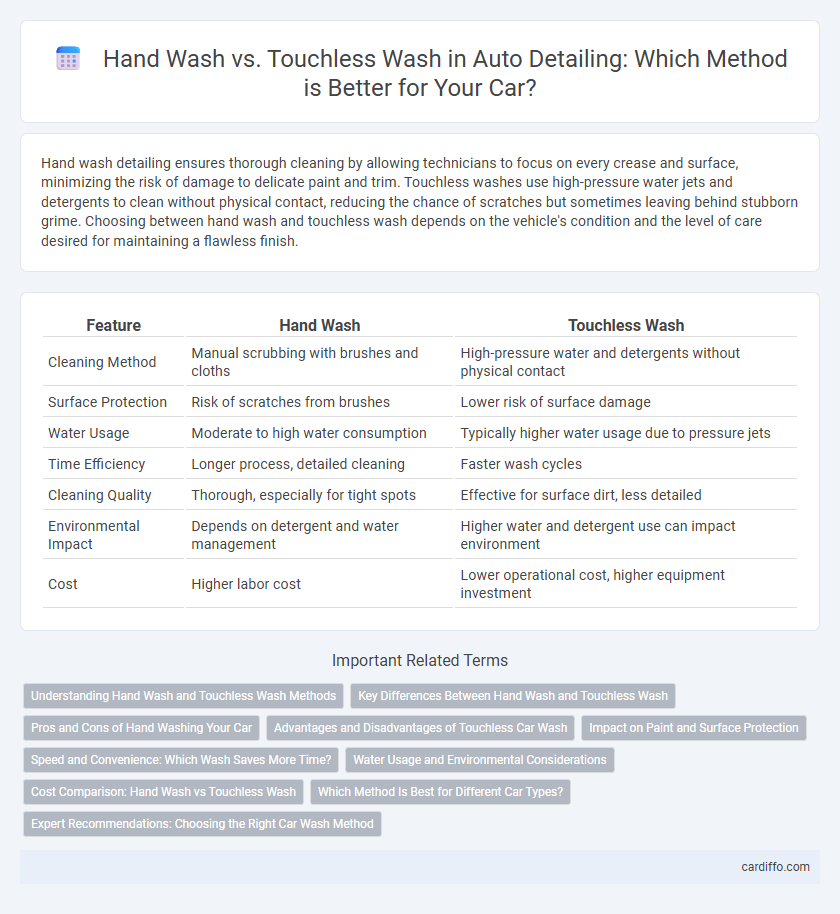Hand wash detailing ensures thorough cleaning by allowing technicians to focus on every crease and surface, minimizing the risk of damage to delicate paint and trim. Touchless washes use high-pressure water jets and detergents to clean without physical contact, reducing the chance of scratches but sometimes leaving behind stubborn grime. Choosing between hand wash and touchless wash depends on the vehicle's condition and the level of care desired for maintaining a flawless finish.
Table of Comparison
| Feature | Hand Wash | Touchless Wash |
|---|---|---|
| Cleaning Method | Manual scrubbing with brushes and cloths | High-pressure water and detergents without physical contact |
| Surface Protection | Risk of scratches from brushes | Lower risk of surface damage |
| Water Usage | Moderate to high water consumption | Typically higher water usage due to pressure jets |
| Time Efficiency | Longer process, detailed cleaning | Faster wash cycles |
| Cleaning Quality | Thorough, especially for tight spots | Effective for surface dirt, less detailed |
| Environmental Impact | Depends on detergent and water management | Higher water and detergent use can impact environment |
| Cost | Higher labor cost | Lower operational cost, higher equipment investment |
Understanding Hand Wash and Touchless Wash Methods
Hand wash detailing involves manual cleaning using brushes, sponges, and microfiber towels to carefully remove dirt and contaminants while minimizing surface damage. Touchless wash methods utilize high-pressure water and specialized detergents to clean the vehicle without physical contact, reducing the risk of scratches and swirl marks. Understanding the pros and cons of each method helps car owners choose the best approach for paint protection and maintenance.
Key Differences Between Hand Wash and Touchless Wash
Hand wash detailing involves manually scrubbing the vehicle's surface with brushes and cloths, ensuring thorough removal of dirt from hard-to-reach areas and preserving delicate paint finishes. Touchless wash relies on high-pressure water jets and chemical cleaners without physical contact, reducing the risk of swirl marks but sometimes failing to eliminate stubborn grime fully. The key differences lie in the level of cleaning precision, potential for surface damage, and effectiveness on heavy contaminants.
Pros and Cons of Hand Washing Your Car
Hand washing your car allows for precise attention to detail, reducing the risk of paint damage from harsh automated brushes and ensuring thorough cleaning of hard-to-reach areas. It requires more time and physical effort compared to touchless washes but provides greater control over the cleaning process and use of specific products tailored to your vehicle's needs. However, improper technique or materials can cause scratches or swirl marks, making knowledge of proper hand washing methods essential to protect your car's finish.
Advantages and Disadvantages of Touchless Car Wash
Touchless car washes use high-pressure water jets and specialized detergents to clean vehicles without physical contact, reducing the risk of scratches and swirl marks often associated with hand wash or brush-based systems. Advantages include faster service, consistent cleaning results, and minimal surface abrasion, making it suitable for delicate paint finishes. Disadvantages involve less effective removal of stubborn dirt and grime compared to hand washing, potential water spots, and reliance on chemical detergents that may be harsher on automotive coatings.
Impact on Paint and Surface Protection
Hand wash provides a gentle cleaning process that minimizes the risk of paint scratches and swirl marks, preserving the vehicle's clear coat integrity. Touchless wash uses high-pressure water and strong detergents, which can effectively clean without direct contact but may degrade protective wax or sealant layers over time. Choosing the right method depends on balancing thorough cleaning with maintaining long-term surface protection and paint finish quality.
Speed and Convenience: Which Wash Saves More Time?
Touchless car washes offer faster service times by eliminating manual scrubbing, reducing the average wash duration to around 3-5 minutes. Hand washes, though more thorough, typically take 20-30 minutes or longer due to detailed interior and exterior cleaning. For customers prioritizing speed and convenience, touchless washes provide a significant time-saving advantage without compromising basic cleanliness.
Water Usage and Environmental Considerations
Hand wash techniques typically consume 60 to 140 gallons of water, whereas touchless washes use high-pressure jets that reduce water usage to approximately 10 to 30 gallons per vehicle. Touchless systems minimize runoff of harmful chemicals and detergents, lowering environmental pollution and water contamination risks compared to hand washing practices. Choosing touchless washes supports water conservation efforts and adheres to stricter environmental regulations on effluent discharge.
Cost Comparison: Hand Wash vs Touchless Wash
Hand wash detailing typically incurs higher labor costs due to manual effort and time required, averaging $20 to $50 more per session compared to touchless wash systems. Touchless washes utilize automated technology that minimizes water and soap consumption, resulting in lower operational expenses and faster service times. Cost efficiency varies based on frequency, vehicle size, and facility overhead, with touchless washes often more economical for routine cleaning while hand washes provide superior quality at a premium price.
Which Method Is Best for Different Car Types?
Hand wash offers precise care for luxury and vintage cars, allowing detailed attention to delicate paint and trim, while touchless wash suits modern vehicles with durable finishes due to its chemical-based cleaning that avoids physical contact. SUVs and trucks benefit from touchless washes as they effectively remove heavy dirt without scratching large surface areas. For sports cars with aerodynamic shapes, hand washing is preferred to meticulously clean crevices and maintain the high-gloss finish.
Expert Recommendations: Choosing the Right Car Wash Method
Experts recommend touchless car washes for vehicles with delicate paint finishes or recent paint jobs, as they minimize the risk of scratches and swirl marks caused by brushes or cloths. Hand washing is favored for thorough cleaning, especially in hard-to-reach areas, and allows for personalized attention using premium cleaning products. For optimal results, combining regular touchless washes with occasional expert hand detailing ensures both protection and deep cleansing of the vehicle's surface.
Hand Wash vs Touchless Wash Infographic

 cardiffo.com
cardiffo.com